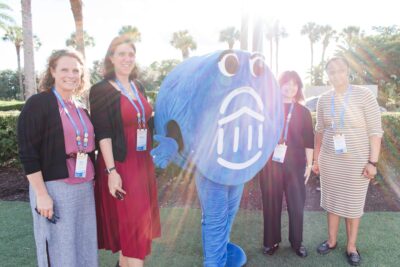How schools are expanding student mental health support without hiring more counselors
Colleges and universities face a slew of “pandemic ripple effects” that pose long-term threats to student success. Of these, the rise in demand for student mental health services stands out as one of the most urgent and swiftly evolving, with as many as three in four students now saying that they considered leaving college at some point over the last six months due to emotional stress.
Few institutions feel that they are fully staffed to meet this challenge. Most mental health strategies focus on directing students to trained mental health professionals who provide care in a clinical setting. While counseling is a critical part of mental health care, unfortunately, mental health professionals are in short supply and often already over capacity. Hiring more of them to meet surging post-pandemic demand may simply be out of the reach of many schools. Colleges and universities will need to evolve their strategy to meet the challenge.
An emerging model relieves the burden on counselors
Fortunately, there are ways to take some of the pressure off counselors while providing students with a better experience. “Stepped Care models” show us how this is possible. Stepped Care organizes mental health services in a continuum based on their intensity. The upper tiers represent high-intensity options such as 1:1 counseling, while the bottom tiers represent lower intensity programs and services. These bottom tiers often include scalable, preexisting services that include (but aren’t limited to) advising, residence life, health and fitness, campus ministries, and student groups.
The lesson we should take from the lower tiers of Stepped Care is that many of the commonplace services we already offer students can rightly be considered “wellness services.” They fall outside the clinical and counseling infrastructure, yet they still play an important role in supporting mental health and wellbeing simply by doing what they are already doing every day.
Driving student engagement with these wellness services redirects some of the demand for formal counseling and can prevent many issues from escalating to the point of needing acute care. Coordinating these services can help schools provide much better support for students without the need for major new investments. The result should be an improvement in overall wellness across the student body.
Supporting the whole student
Stepped Care is grounded in the understanding that the entire community can play a role in supporting mental health and well-being. Another model, the Eight Dimensions of Wellness, shows us how the to apply this concept to its fullest extent. The Eight Dimensions of Wellness, developed by Dr. Peggy Swarbrick at Rutgers University and embraced by the US Substance Abuse and Mental Health Services Administration, is a strengths-based model to promote mental health and wellbeing. It’s based on the idea that wellness is a holistic concept that encompasses multiple dimensions of a person’s life: Physical, Emotional, Intellectual, Social, Occupational, Environmental, Spiritual, and Financial.
Each of the eight dimensions is important in achieving a state of overall wellness and balance in life, and the dimensions often interact with and influence each other. By addressing all the dimensions, individuals can work towards achieving a state of overall wellness and balance in their lives.
Putting it together: Aligning campus services with every dimension of student wellness
Stepped Care models show us that our non-clinical programs and services have a role to play in supporting student wellbeing, and the Eight Dimensions model gives us a blueprint for doing so in a way that is holistic and grounded in established theory. By combining these concepts, we can align our programs and services to support wellbeing more effectively.
Faculty, administrators, and staff also have a role to plan in this aligned model, often simply by doing what they do best. This may come as a welcome relief for these critical stakeholders who recognize the challenge at hand but aren’t sure how they can help.
Here’s an example of what an aligned might look like. We encourage you to use this as a guide for thinking about an aligned model that fits with your unique services, assets, and campus culture.
Emotional
Understanding and managing one’s feelings
People and Services
- Student Affairs
- Counseling
- Student Success
- Accessibility Services
Intellectual
Pursuing lifelong learning and personal growth
People and Services
- Faculty
- Student Success
- Advising
- Mentoring/Tutoring
- Accessibility Services
Physical
Maintaining a healthy body through exercise, nutrition, and sleep
People and Services
- Wellness Center
- Health Center
- Recreation Center
- Residence Life
- Auxiliary Services
- Accessibility Services
Social
Forming and maintaining healthy relationships with others
People and Services
- Student Affairs
- Student Success
- Student Organizations
Occupational
Deriving satisfaction and fulfillment from one’s work, and achieving a balance between work and personal life
People and Services
- Faculty
- Career Services
- Experiential Learning
Environmental
Appreciating one’s surroundings and making positive contributions to the environment
People and Services
- Student Affairs
- Residential Life
- Auxiliary Services
Spiritual
Exploring and developing a personal belief system and values that provide a sense of purpose, meaning, and direction
People and Services
- Campus Ministry
- Student Organizations
Financial
Managing one’s finances in a responsible and sustainable manner to achieve a sense of security and stability
People and Services
- Financial Aid
- Bursar
- Career Services
A role for technology
College and universities can use student success technologies like Navigate and Starfish to proactively engage students with people and services that support their Eight Dimensions of Wellness. These technologies already excel at connecting students with the advising and academic support that contribute to their Intellectual wellness, and we increasingly see institutions expanding use cases to include other dimensions.
Our team pulled together a list of top features that can be used to build these connections. As you think about your aligned model, we encourage you to think about how these features could be used by the people and service to support each of the Eight Dimensions:
- Proactive communication – Send customizable wellness content to students at critical points in the term
- Surveys – Get feedback directly from students that can be used to inform their care and support
- Alerts – Allow the community to identify and flag students for follow-up with support
- Progress reports – Make it seamless for faculty to submit alerts for students in their courses
- Hand Raise – Empower students to raise alerts on themselves and ask for help
- Cases – Manage and track interventions resulting from alerts
- Mobile app – Improve your connection to students by interacting directly with them on their phones
Note: Some features are exclusive to either Navigate or Starfish.
Case Study: Hand Raise
Developing “help-seeking behaviors” builds a student’s confidence and feelings of empowerment, which in turn also contributes to their wellness. It’s also the most efficient and scalable way to get students connected with support.
Hand Raise can be configured to prompt preloaded messages or in person follow-up, and it can be set up for any office on campus that is live on their Navigate or Starfish platforms. Navigate partners can go a further step and make Hand Raise available right on their students’ mobile apps, making it super easy for them to connect with help.
Let’s take the next steps together
Please reach out to your Navigate Strategic Leader if you would like to take the next steps to set up proactive outreach in support of students’ mental health and well-being. We encourage you to check out our open-access Mental Health Resource Center and this summary blog for more ideas on how to expand your mental health and well-being strategy.
Author’s note: This ideas in this blog represent the combined efforts of a team of EAB student success and student affairs experts who have backgrounds in studying or providing mental health and wellbeing care. We want to acknowledge and thank them for their important contributions:
| Kate Brown | Andrina Musser, MSSW | |
| Becky Carpenter, MS OTR/L | Matt Mustard | |
| Jessica King, Ed.D. | Liz Rothenberg, Ph.D. | |
| Melissa Lantta, Ph.D. | Lindsay Schappell, LCSW |

More Blogs

Four signs it’s time to break up with your student CRM

Three lessons from 1,200 student success leaders on higher ed’s future
